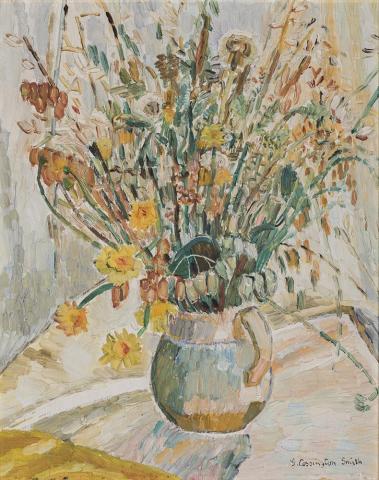WILD GRASSES, c.1936
GRACE COSSINGTON SMITH
oil on board
29.0 x 23.0 cm
signed lower right: G. Cossington Smith
signed and inscribed verso: Wild Grasses / Grace Cossington Smith
Macquarie Galleries, Sydney (label attached verso)
Private collection
Sotheby's, Melbourne, 17 April 1989, lot 441 (as ‘Flower Arrangement with Jonquils’)
Eva Breuer Fine Art, Sydney
Private collection, New South Wales
The Show of Fives, The Macquarie Galleries, Sydney, 9 – 28 February 1944, cat. 32
This bunch of modest native grasses loosely arranged in a squat ceramic milk jug and faithfully detailed on board is an expression of prosaic beauty and the artist’s love of the Australian bush. Grace Cossington Smith, a pioneering female artist, was dedicated to creating a vision of urban and domestic life in Australia in which a new national identity could be celebrated. Like many of her peers, particularly female artists from between the wars, Cossington Smith’s emotive artistic responses to her surroundings expressed her belief in and advocacy for a greater artistic appreciation of local context. This painting, Wild Grasses, c.1936 was exhibited at Sydney’s Macquarie Galleries in 1944, in The Show of Fives, a show in which, remarkably, over fifty percent of the works were created by female artists, attesting to the prolific creative spirit of women in Sydney during the inter-war period and the recognition that they came to enjoy.
Belonging to a popular group of works within the artist’s oeuvre, all featuring wildflowers placed in jugs, vases and buckets against folds of white, brown and yellow drapery, Wild Grasses is an understated composition that strikes a harmonious balance between formal structure and expressive looseness of line and colour. From the 1920s onwards, Cossington Smith painted many arrangements of native flora, moving from graphic stylisation and saturated colour to more nuanced compositions of soft colour and closely examined texture. Rustic in colour and structure, Wild Grasses respects the untameable and rough qualities of the Australian bush. Rioting against the confines of the ceramic jug, the tangle of wild blades of grass, rough seed pods and blooms becomes a graphic exploration of form, line and colour. Cossington Smith’s characteristic fragmented brushstrokes convey the scruffy beauty of the Australian bush but also create a spontaneous and dynamic composition in tune with this new, fast-paced modern world. The artist’s radical reconsideration of traditional mimetic representation also led to the creation of iconic images of a city on the cusp of industrial prosperity, such as The Bridge in-curve, c.1930 in the collection of the National Gallery of Victoria, Melbourne.
This composition is dominated by soft chalky tones, with highlights of the artist’s distinctive golden yellow which would come to inundate her later works. As seen in the blooms of Wild Grasses, Cossington Smith’s gold hue also served a structural purpose, bringing forms within the picture plane toward the viewer .1 Cossington Smith showed great sensitivity to the tonal nuances of her surroundings, creating works that were described at the time as ‘happy pictures… [painted] for no other reason than to express her pleasure in life’.2
The artist spoke of her appreciation of wildflowers and their significance in creating a spirit of place, in 1965: ‘[The] Australian wildflowers are quite on their own, they are the most lovely things that we have and their colour… is soft, brilliant colour like our atmosphere, which is very wonderful. I’m particularly fond of the Australian bush, with its marvellous soft colour and colour of the gum trunks, themselves, the pink and the whites, the reds and greys and blacks.’3
1. Thomas, D., Grace Cossington Smith, Art Gallery of New South Wales, Sydney, 1973, p. 7
2. Anderson, E., ‘Happy pictures by a young Australian artist’, Walkers Monthly, London, April 1932
3.Cossington Smith, G., interview with De Berg, H., Sydney, 16 August 1965, quoted in Hart, D. (ed.), Grace Cossington Smith, National Gallery of Australia, Canberra, 2005, p. 65
LUCIE REEVES-SMITH
